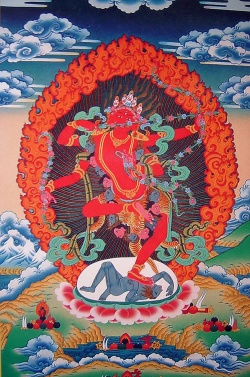Kurukulla
- See also :
- See also :
Kurukulla (Skt. kurukullā; Tib. རིག་བྱེད་མ་, rikjéma; Wyl. rig byed ma) — a female deity of the Lotus family, associated with the activity of magnetizing.
She is usually depicted as red in colour, in dancing posture and holding a flowery bow and arrow. She is also one of the Twenty-One Taras mentioned in the ancient Tara tantras.
External Links
Source
Kurukullā (Tibetan: rig che ma, English: The One of the Action Family), Goddess of Power.
Powerful, red in colour with one face, hair flowing upward, three eyes and four hands, slightly fierce in expression, she holds a bow and arrow in the first pair of hands and a hook and lasso in the lower pair.
All the hand objects are constructed of red utpala flowers and used as implements for the subjugation of others.
Adorned with jewel ornaments, a tiara, earrings, necklaces, bracelets and silk scarves, she wears a lower skirt of tiger skin. Standing atop a corpse, sun disc and lotus blossom she dances amidst the circular flames of the fire of pristine awareness.
The goddess of power, Kurukulle, is one of the twenty-one forms of the goddess Tara. She ensures that one gains power over any activity desired and dispels obstacles.
Tibetan Buddhism holds if those who engage in business or who seek an attractive partner rely on and worship her, she can surely grant the accomplishment of whatever one wishes-for example, conferring without hardship her hook and lasso that can draw in what is desired.
Source
Kurukullā. (T. Dbang gi lha mo). Sanskrit proper name of a form of Tārā; Kurukullā appears in both peaceful and wrathful manner, generally red in color. Wrathful, she stands in Ardhaparyaṅka Āsana, one face with three eyes, wearing a crown of skulls and holding in her four hands a bow and arrow and snare (pāśa) and displaying the Abhayamudrā. When peaceful, she is portrayed in seated posture and has eight arms. Kurukullā is propitiated in a rite of Vaśīkaraṇa, by which men are bewitched. She is therefore considered the Tārā of love, propitiated by women seeking success in romance. Her mantra is oṃ kurukulle hrī svāhā.
Source
The Princeton Dictionary of Buddhism by Robert E. Buswell Jr. and Donald S. Lopez Jr.
